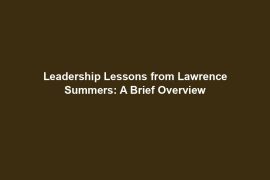Hey there, history buffs and aspiring leaders! Today, I want to take you on a journey back in time to explore the fascinating leadership qualities of President James Garfield.
James Garfield wasn’t just your average president. Born in a humble log cabin in Ohio, he rose to become the 20th President of the United States. Sadly, his time in office was cut short by an assassin’s bullet, but during his brief presidency, he displayed remarkable leadership skills that we can still learn from today.
Now, you might be wondering, why should we bother studying leadership lessons from someone who lived over a hundred years ago? Well, my friend, history has a way of teaching us valuable insights that are timeless. By looking at the successes and failures of leaders like Garfield, we can gain a deeper understanding of what it takes to be an effective leader in any era.
In this blog post, we’ll delve into two key leadership lessons from James Garfield’s presidency. We’ll explore how his vision and communication skills set him apart as a leader, as well as how his adaptability and collaboration were crucial to his success. So get ready to be inspired by a true historical hero as we uncover the secrets to effective leadership in the modern world. Let’s dive in!
Leadership Lesson 1: Vision and Communication
One of the most important lessons we can learn from James Garfield’s presidency is the power of having a clear vision and effectively communicating that vision to others. Garfield was able to articulate a strong sense of purpose for his presidency, outlining his goals and priorities with clarity and conviction.
When it came to communication, Garfield was a master at getting his message across to both the public and his administration. He used his eloquence and persuasive skills to rally support for his policies and initiatives, effectively garnering the backing needed to see his vision come to fruition.
For example, Garfield’s Honesty in Government speech resonated with the American people, as he laid out his commitment to transparency and accountability in public service. This message not only inspired trust among the public but also set the tone for his leadership style throughout his presidency.
Impact of Vision and Communication
Garfield’s ability to clearly articulate his vision and effectively communicate with others had a profound impact on his leadership. It allowed him to inspire confidence and unity among his followers, paving the way for successful implementation of his policies and initiatives.
By studying Garfield’s approach to vision and communication, we can learn how to craft compelling messages that resonate with others and drive positive change. Whether in the workplace or in our personal lives, the importance of having a clear vision and communicating it effectively cannot be understated.
Leadership Lesson 2: Adaptability and Collaboration
Now that we’ve covered the importance of vision and communication in leadership, let’s dive into another crucial aspect of leadership that James Garfield excelled in – adaptability and collaboration.
Adaptability:
During his presidency, Garfield faced numerous challenges and obstacles that required him to adapt quickly to changing circumstances. Whether it was navigating the complexities of post-Civil War politics or dealing with economic issues, Garfield showed a remarkable ability to adjust his strategies and approach in order to effectively lead the country. His willingness to evolve and adjust his tactics based on the situation at hand set him apart as a leader who was able to thrive in times of uncertainty.
One particular example of Garfield’s adaptability was his handling of the contentious debate over civil service reform. Despite facing resistance from within his own party, Garfield remained steadfast in his commitment to reforming the corrupt civil service system. By being flexible in his approach and open to new ideas, Garfield was able to eventually pass the Pendleton Civil Service Reform Act, a landmark piece of legislation that paved the way for a more merit-based government workforce.
Collaboration:
Another key aspect of Garfield’s leadership style was his willingness to collaborate with individuals from diverse backgrounds and perspectives. Unlike some leaders who surround themselves with like-minded individuals, Garfield actively sought out differing viewpoints and was open to working with members of both parties. By fostering a culture of collaboration and inclusivity, Garfield was able to build consensus, bridge divides, and achieve bipartisan support for his initiatives.
One of the most notable examples of Garfield’s collaborative approach was his work on the Treaty of Washington, which settled longstanding disputes between the United States and Great Britain. By working closely with his political opponents and enlisting the help of experts and advisors from various fields, Garfield was able to negotiate a successful treaty that not only resolved contentious issues but also strengthened diplomatic relations between the two countries.
Overall, Garfield’s ability to adapt to changing circumstances and collaborate with diverse viewpoints was instrumental in his success as a leader. His example serves as a powerful reminder of the importance of flexibility and open-mindedness in effective leadership.



